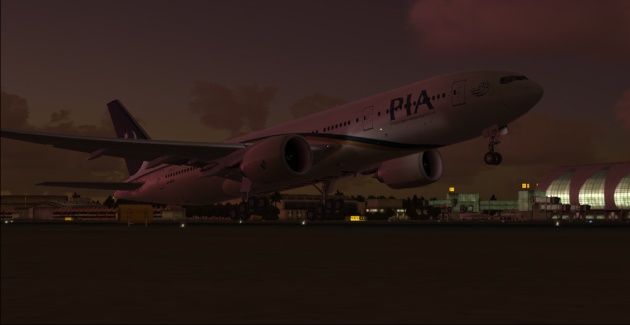
Introduction
Today the airplanes are safest than they ever were. In human history, the achievement of flight was one of the most considerable and an amazing event. It changed the the means of travelling a lot. People started covering larger distances in very short time, but flying is a hard task for a pilot , sometime the job is so demanding that it requires more than human abilities, like "staying attentive on long haul flight can be really annoying and tiring for pilots". This issue had to be solved, as it was leading to In-flight Human Errors which further lead to Air Crashes and loss of very precious human lives. Elmer Ambrose Sperry had already invented auto-pilot by 1914, which gained attention of aircraft building companies and was a possible solution to this issue.
Today we have worked a lot on auto-pilot and made it so sophisticated and reliable that 85% of flying the aircraft is done by auto-pilot and rest by pilots. Now a days pilots mostly monitor the instruments in cockpit while auto-pilot flies the airplane. Auto-pilot has become so advance that it can land the aircraft if the Runway is equipped with ILS-CAT III (Instrument Landing System CAT-III).
HOW DOES AUTO-PILOT WORK?
Auto-Pilot is divided into many parts, each part has its own functionality. The basic configuration of auto-pilot is done from FMC (Flight Management Computer), which feeds the basic data needed for auto-pilot to fly an aircraft.
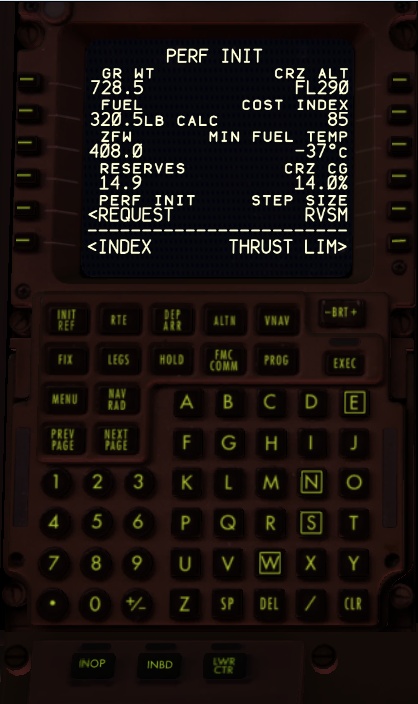
*FMC OF A BOEING 777-240LR SHOWING PERFORMANCE INITIALIZATION PAGE
After the FMC is configured, now the whole working of auto-pilot depends upon MCP (Mode Control Panel) of an aircraft , where there are several switches responsible for operation of several functions of an aircraft. In the coming part we will discuss MCP of a Boeing 777-240LR and some various auto-pilot controls it offers.
The Picture below shows MCP of a Boeing 777-240LR , I have tried to make it easy for you guys and divided in parts. Each division is allotted it's specific number, which I will explain with reference to its number in my blog below. Each number will show the explanation of its part.
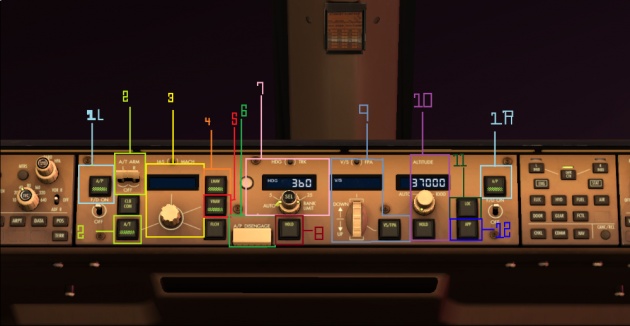
*MCP (Mode Control Panel) Of A Boeing 777-240 LR
1L And 1R (A/P Switch) :- The 1L and 1R switches that indicate A/P (Auto-Pilot) have similar function. Left is captain side whereas Right is First-Officer's (Co-Pilots) side. These switches are known as Master Auto-Pilot switch. It brings the auto-pilot functionality of aircraft to life. Without this button active, auto-Pilot cannot fly the aircraft, or in some cases some of its functionalities won't work.
2 (A/T Arm Switches And A/T Button) :- The A/T Arm (Auto Throttle Arm) switches makes the auto-pilot ready to take control of the IAS (Indicated Air Speed) of the aircraft, while the A/T (Auto Throttle) button gives the control to of IAS to the auto-pilot from pilots. Without A/T Arm switches on , ON position, the A/T button will not activate, hence auto-pilot wont take control of IAS.
3 (IAS Display And Knob) :- Here in the picture above, the IAS Display (small rectangular screen above the knob) is black because aircraft is flying on VNAV (Vertical Navigation) mode, which is controlling speed of aircraft and maintaining it to the speed that was set in FMC by pilots during pre-flight checks, but when aircraft isn't flying on VNAV or when the Knob below the display is pressed inside while flying on VNAV, the speed control will be taken from VNAV and given to A/T. The current speed will be displayed on the screen which can be set to desired speed later and after setting the speed, auto-pilot will bring aircraft on that speed. Rotating the knob will set the speed.
4 (LNAV Button) :- LNAV (Lateral Navigation) is something I find very interesting. Pressing this button will take the aircraft into the mode where the aircraft will navigate itself on the route fed in FMC and fly to destination itself. See the picture below for understanding better. 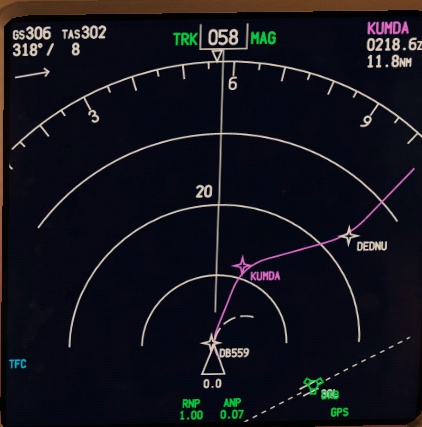
This is ND (Navigation Display) of a Boeing 777-240LR , it provides pilot a lot of information, but for now we will about stuff related to LNAV. The Pink line of a type on the ND is the route for destination that was fed in FMC and the white big Triangle is the aircraft. With LNAV activated, the auto-pilot will align to the pink line and continue for destination. The route is divided in way points, for e.g KUMDA.
5 (VNAV):- Pressing VNAV ( Vertical Navigation Button) will control speed , climb and descent of aircraft.
6 (A/P Disengage):- A/P stands for auto-pilot and we know meaning of disengage. This switch will take control from auto-pilot and give it back to pilot. However usually on a Boeing 777-240LR pilots disengage it from a button on control yoke. There a lot of other ways to disengage the auto-pilot too!
7 (Heading Display , Heading Knob, Sel Button And Bank Angle Selector):- Heading display shows the heading that was set from knob. Here there are two Knobs, the upper knob will change the heading and the display will show us the heading we are rotating the knob to. Pressing Sel (Select) Button will select the heading indicated in display and the aircraft will start turning to wards that heading, but LNAV mode shall must not be activated while doing this. The lower knob selects the angle limit to which the auto-pilot can bank the aircraft.
8 (HOLD Button):- Pressing this HOLD Button will cancel the turn of aircraft and make the aircraft maintain its current and present heading.
9 (V/S Display , V/S Wheel and VS/FPA Button):- The V/S (Vertical Speed ) display shows the value of descent or climb in feet/min which is selected using knob or the wheel. VS/FPA button will active the value and aircraft will start climbing or descending with that value, towards altitude set in altitude display. VNAV shall must not be active doing this.
10 ( Altitude Display , Upper Knob , Lower Knob And HOLD Button):- Altitude display shows the altitude you want to climb to, or you want to descent to. You can change it from upper knob, the units are in feet. The lower knob is used to select the rate of change of altitude the upper knob makes when its rotated. You either set it to 100 feet or 1000 feet, after when you rotate the upper knob the change will be either 100 feet or 1000 feet. The HOLD Button cancels the climb or descent state of aircraft and levels it off on present altitude.
11 (LOC Button):- While making an ILS approach, pilots turn on LOC which aligns them with center runway line and gives them a glide slope to runway for landing. In short it makes interception of localizer and dose not control the pitch of aircraft.
12 (APP Button):- When localizer is intercepted during ILS approach, the pilots press the APP Button which controls pitch and bank of aircraft and brings in aircraft to land. It can completely land the aircraft if ILS is CAT-III.
Related Videos
KLM Cockpit Tales: Part 1 - Autopilot in action (Credits: KLM )
Using the autopilot Mode Control Panel Boeing 777-300ER (Credits: Hamair777s)
KLM Cockpit Tales: Part 2 - Crossing the Atlantic (Credits: KLM)
Boeing 777's AutoPilot Tutorial - FlightGear HowTo #32 (Credits: osjcag)
Real World Pictures Of PIA's B777-240LR (AP-BGK)

PIA - Pakistan International Airlines AP-BGK aircraft at Manchester (Source: www.airplane-pictures.net)

Pakistan Boeing 777 AP-BGK leaves a mass of spray shortly after a rain shower departing runway 24L for Toronto on 28th December 2004. (Source: www.skyscrapercity.com )

PIA AP-BGK PK771 from Lahore to CPH and onwards to Oslo later, here. Landing on 22L The weather changed a lot from the earlier shots til now. (Source:www.historyofpia.com )

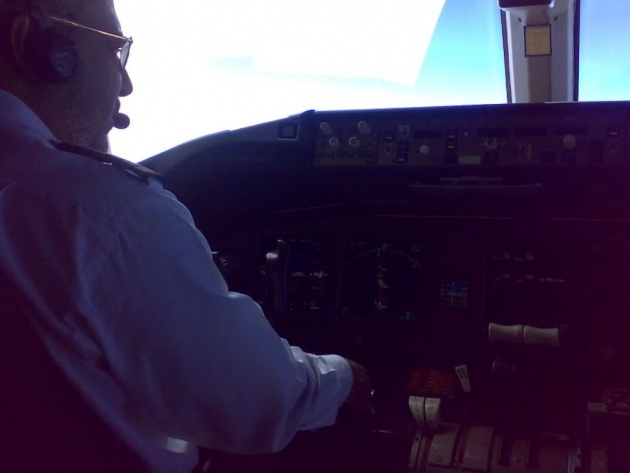
AP-BGK Cockpit. (Source: http://s118.photobucket.com/user/suk-2005/media/ap-bgk/08092007019.jpg.html )
About Me
Hey! I'm Abdalla Syed and I have been flying on Simulator, since past 4 years and am part of VATSIM community since past 1 year. Im VATSIM P1 rated pilot, P2 theory passed and practical check to go and Boeing 777 commander with PIAV. Flew Cross The Atlantic 2 times, 1 time participating in VATSIM GRAND CTP Event 2k15 (East bound). Also I have obtained S1 ground controller rating of VATSIM from Pakistan vACC. In real I'm a trainee pilot going through my basic training.
Questions In comments will be entertained.
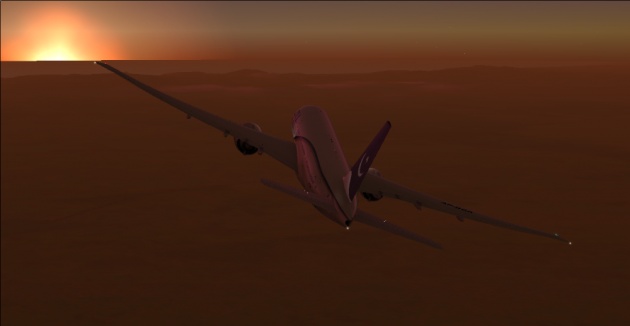
*Note all the simulator pictures in above blog are from my Flight Simulator X and Addon Aircraft is PMDG777. The blog is for study purpose only.



